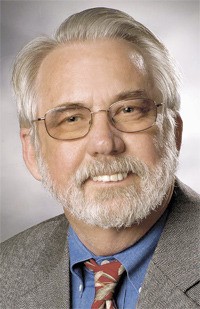A spokesman for the state Department of Ecology recently told the Auburn Reporter that the toxic plume of tri-chloroethylene that had slipped underground and escaped Boeing property years ago appears to pose minimum risk to nearby Algona — at this time.
But to Algona’s leaders and to the residents who may lie in the path of the plume of this known carcinogen — Boeing used the chemical decades ago to degrease its airplane parts — the recent behavior of the DOE, the Department of Health and The Boeing Co. offer cold comfort.
After all, it has not escaped the public’s attention that the DOE and Boeing said at first that the spill wasn’t in Algona — but it turned out to be there.
That they then said OK, it’s in Algona, but only in the industrial section — and now technicians are looking at the residential areas.
Algona Mayor Dave Hill put it this way: state and Boeing, if there’s the minimum danger that you claim there is, what’s lit the fire under you to dig all those test wells, which will soon number more than 200?
Hill asks these questions every day. Getting answers to them, he said, is absolutely critical for the city and its residents.
That nobody can tell him the answers alarms him.
“What has happened is we don’t know how bad it is yet,” Hill said. “At one time they’re saying there’s nothing to worry about, but we need to do all these tests … They still don’t know the parameters of the plume, and it’s been 11 years, and that is really unheard of. It took nine years to actually exit the Boeing property.”
Hill first learned of the spill in late October of 2011. In November of that year, Boeing and the DOE assured the mayors of Auburn, Algona and Pacific that there was nothing to worry about, testing was all they would be doing when the spring of 2012 rolled around.
While the state promised the results of that initial testing would be released in March of 2012, it failed to release them to the public until February of 2013. That nearly year-long delay went a considerable distance toward convincing everybody that the state and Boeing had something to hide.
“… There is a lack of trust right now from the City of Algona, both from the City Council and myself and the residents, with the Department of Ecology and Boeing on this whole matter because we really feel like we were not consulted or informed,” Hill said. “They keep saying ‘there’s nothing wrong, but we’ve got to do more.'” I liken that to going to my doctor and having the doctor say, ‘You’re in perfect health, Dave, but I’m admitting you to the hospital.'”
Larry Altose, a spokesman for the DOE, told the Auburn Reporter recently that the state will conduct a new round of tests this spring and dig more wells on the north end that could offer more answers.
Not enough, said Hill. He said the entire city should be tested.
Hill: Possible vapors are worrisome
Hill’s concern is not so much about drinking water contamination — according to a report issued by the Department of Health in January of 2012, a layer of impermeable clay and rock separates the ground water from the aquifer that supplies Algona’s drinking water — as it is with the possibility that the vapors could evaporate and rise into homes.
Rhonda Kaetzl, Health Assessor and Toxicologist with the Sites Assessment and Toxicology Section of the Washington State Department of Health, authored that January 2012 report, titled, “Evaluation of groundwater contamination Boeing Commercial Airlines Fabrication Division, Auburn King County, Washington State.”
Among Kaetzl’s conclusions: “The DOH cannot determine at this time if people are breathing indoor air containing chlorinated solvents that have evaporated from groundwater at the top of the water table and moved into a building through cracks and holes in the foundation. The information we need to determine if exposure is occuring is not available,” Kaetzl wrote, noting, however, that historical modeling indicates that harm to the health of human beings via evaporation is not likely to occur.
“…An updated evaluation of the vapor intrusion pathway is necessary to evaluate potential health risks at the AMB Property Corporation, YMCA and Junior Achievement buildings as well as other buildings located over highest contaminated areas of the shallow groundwater plume,” Kaetzl wrote.
The City has hired ICF International as a consultant. The idea there, Hill said, is assure the City that it is getting accurate information, which it no longer trusts The Boeing Co. and the DOE to deliver.
More testing is needed, Hill said, adding that he is trying to work out arrangements with Boeing and DOE that could result in additional testing beginning this week.
“We have no idea of how much got in, so we don’t how much is dissipated. It spilled in the 80s. Boeing knows it came from a certain part of their building, near the YMCA and Junior Achievement on Perimeter Road, but they don’t know where the plume started. The testing is not final. Testing moves in increments of a couple blocks at a time, and at the rate they’re moving, it may not be final for another 20 to 30 years,” Hill said.


